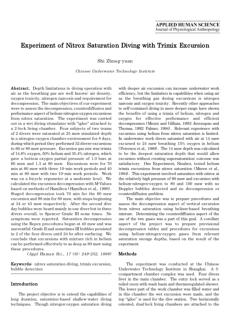Scientific papers 1996 - 1998









Authors: Doctors Shield & Lee
This report is part of the documents that have initiated the
implementation of the UK HSE diving bottom time limits
that are in force in British waters. Also, they have been
adopted by IOGP in the recommended diving practices of
the association.

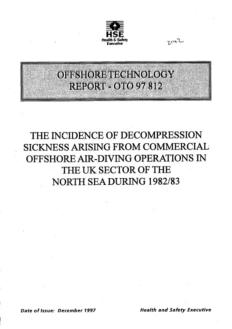

Authors: B. W. Hamill, J. E. Hendrix, L. J. Crepeau, J. D.
Pelton, M. D. Miley, E. E. Kadlec:
This document relates experiments where speech
Intelligibility was measured with US Navy divers
participating in deep saturation dives and a group of non-
divers to test different communication systems and their
components.
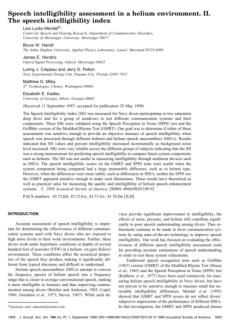

Authors: R. Gelfand, C. J. Lambertsen, J. M. Clark, E.
Hopkin
The investigations described in this report included
observing the development rates of visual, auditory-
vestibular, neurological, pulmonary, cardiac, mental
performance, and respiratory effects of hyperoxia over the
O2 pressure range of 1.5–3.0 ATA.
Year of publication: 1998
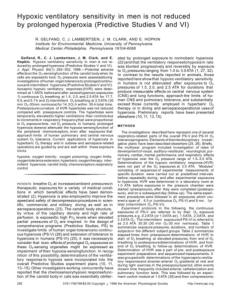

This document describes the Magnetic Resonance
Imaging (MRI) findings in a patient with spinal
decompression sickness. The authors conclude that
Magnetic Resonance Imaging (MRI) may facilitate the
early diagnosis of spinal decompression sickness.
Date of publication: September 1998


Authors: Romuald Olszanski, Zbigniew Baj, Andrzej
Buczynski, Maciej J. Konarski, Ryszard Klos,
Stanislaw Skrzynski, and Krzysztof Zeman.
The evaluation of decompression tables and individual
sensitivity to decompression disease is primarily based on
the detection of symptoms. Thus, not on physiological but
pathophysiological criteria.
The above situation imposes research into such diagnostic
methods that would allow for the evaluation of the
decompression system applied. Apart from the "bends"
criteria and Doppler monitoring of gas bubbles and blood
flow, hemostasis evaluation may well be an indicator that
the decompression is correct
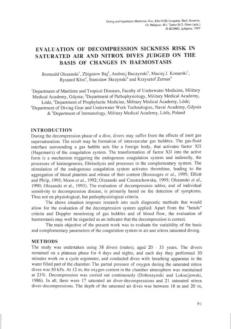

Authors: Van Liew, Hugh D., and Soumya Raychaudhuri
The authors previously outlined the fundamental
principles governing stabilized bubbles' behavior, such as
the microbubbles being put forward as ultrasound
contrast agents.
In this document, their goal is to develop the idea that
there are limits to the stabilization and to provide a
conceptual framework for comparing bubbles stabilized
by different mechanisms.
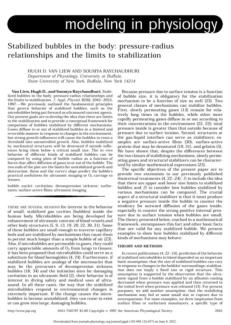

Authors: Philip P Foster, Johnny Conkin, Michael R. Powell,
James M. Waligora, & Raj S. Chhikara
The authors hypothesize that metabolic gases play a role
in the initial explosive growth phase of bubble formation
during hypobaric exposures. Models that account for
optimal internal tensions of dissolved gases to predict the
probability of occurrence of venous gas emboli were
statistically fitted to 426 hypobaric exposures from
National Aeronautics and Space Administration tests.
The presence of venous gas emboli in the pulmonary
artery was detected with an ultrasound Doppler detector.
The model fit and parameter estimation were done using
the statistical method of maximum likelihood.
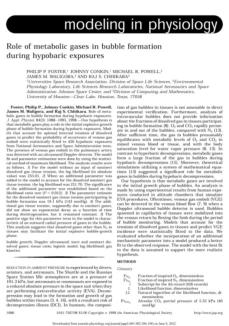

Author: Paul K Weathersby
While probabilistic models of human decompression
sickness (DCS) have been successful in describing both
the level and timing of DCS risk in a wide variety of N2-
O2 data, they have failed to account for the observed
DCS risk in the currently available collection of dives with
significant periods of 100% oxygen breathing. The best
model to date, calibrated with over 2300 air and N2-O2
dives, under-predicts the DCS risk of these O2 dives by
60%, whether O2 is breathed during in-water
decompression or during surface decompression
procedures. This overestimation of the benefit of O2 is
due to an exaggerated acceleration of N2 wash-out
during O2 breathing.
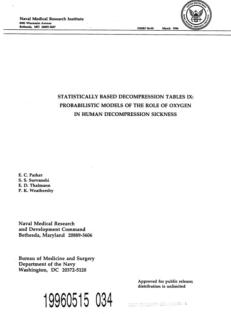

Author: Paul K Weathersby
Underwater decompression meters or computers sense a
diver's changes of depth in real-time and calculate a
decompression schedule for the individual diver's
exposure. Currently available devices compare calculated
nitrogen tissue tensions to a set of stored “safe” constants.
No explicit quantitative connection between these rules
and the risk of decompression sickness has been
established. Well calibrated probabilistic models, even
though computationally more intense, can be used to
specify decompression procedures tailored to control the
risk of decompression sickness...
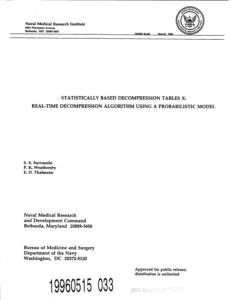

Authors: A. Boussuges, P Ambrosi, G Habib, D Cartran, B.
Gardette, JM Sainty
Detection of circulating bubbles can be used as an
indicator of the safety of a dive and his decompression
procedure. Continuous wave Doppler is the more widely
used but the analysis of the signals obtained involve a
degree of subjectivity. Then, the inter-rater agreement on
the grading of intravascular bubble signals can be
important and statistics of studies with a few records can
be falsified. Others ultrasonic methods for detecting
bubbles have been evaluated. Echocardiography can
visualised circulating bubbles in right cavities.
Transesophageal echocardiography is semi invasive and
only used during experimental animal studies.
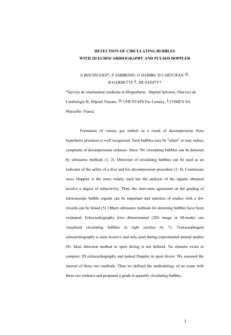

Authors: R. Arieli, A. Gutterman
The development of oxygen toxicity can be delayed by
intermittent periods of normoxia. In this document,
doctors Arieli and Gutterman show a procedure for
quantifing the recovery during normoxia, so a process
that allows calculating the accumulation of oxygen toxicity
and its recovery to evaluate central nervous system
oxygen toxicity.
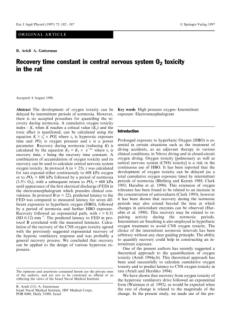


Author: Goran E. Nilsson
This document explains the fundamentals of oxygen
sensing, uptake, and transport. It also shows examples of
extreme respiratory performance, such as diving and high-
altitude survival in mammals and birds, air-breathing in
fish, and those few vertebrates that can survive without
oxygen for several months.
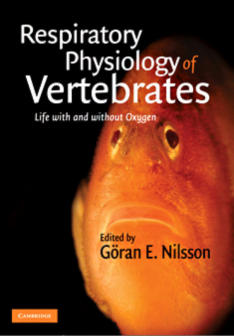

Authors: J. C. Le Péchon, P. Barre, J. PBaua'i, F. Ollivier
This document is a presentation of the MT92 for tunneling
operations requiring compressed air work, and an analysis
of the 1st operations performed with this table.
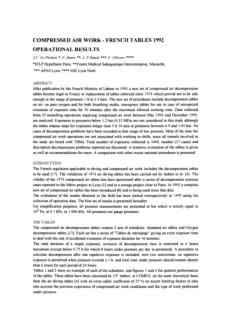

Author: Mark Kessler
This document is a study of tables made in 1998 for the
Canadian Underwater Minecountermeasures (MCM)
Apparatus (CUMA), a self-contained, semi-closed circuit
breathing apparatus in service with the Canadian Forces
(CF) for diving on underwater mines to a depth of 81
metres of seawater (msw) using a mixture of helium and
oxygen (HeO2). .
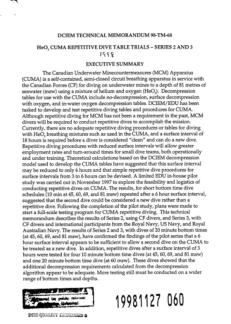

Authors: C. Rostain, M. C. Gardette-Chauffour, & R. Naquet
To study the effects of nitrogen addition to the breathing
mixture on sleep disturbances at pressure, two dives were
performed in which helium-nitrogen oxygen mixture was
used up to 450 m sea water (msw). In total, sleep of 12
professional divers was analyzed (i.e., 184 night records).
Sleep was disrupted by compression and by stay at 450
msw: The authors observed an increase in awake periods
and in sleep stages I and II and a decrease in stages III and
IV and in rapid-eye-movement sleep periods.
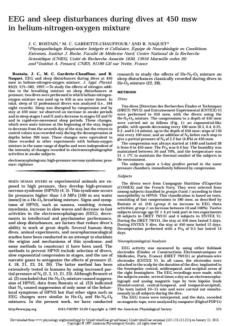

Authors: O. Hyldegaard, J. Madsen
This paper describes studies on the effect of sulfur
hexafluoride/oxygen breathing on air bubbles injected
into skeletal muscle, rat-tail tendon, the anterior chamber
of the eye, and spinal white matter. Decompression-
induced nitrogen bubbles in adipose tissue was studied.
The results were compared with previous experiments
using heliox 80/20.
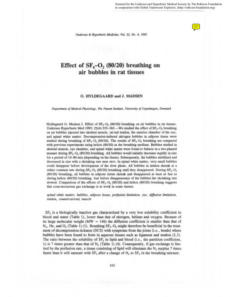

Author: Michel B. Ducharme, Christopher J. Brooks
This study was designed to investigate the effect of
standard wave conditions (0 to 70 cm) on dry immersion
suit insulation when tested on humans and a mannequin
simultaneously. The objectives of the study were:
•
To see if the thermal insulation of suits used on a
manikin and humans is equally affected by wave
motion;
•
To determine which component of the suit is most
affected by wave motion.
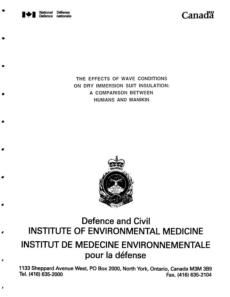


Click on the octopus
to return to the top
of the page

Authors: N.B. Hampson and R.G. Dunford
The "cold-induced pulmonary edema" syndrome was first
described in 1989, affecting scuba divers in cold European
waters. The authors observed six similar cases, five in
Puget Sound and one in the Gulf of Mexico, involving four
women and two men aged between 24 and 60. This
syndrome can occur in both cold and warm waters and is
not related to decompression sickness. Medical personnel
should be familiar with this condition to manage it
effectively.

Authors: V. Lafay, A. Boussuges, P. Ambiosi, P. Barthelemy,
Y Frances, B. Gardette,and Y. Jammes
This study focused on the heart's pumping ability and the
blood flow during the dive. The findings showed a
decrease in heart rate, which led to a reduced overall
heart output, while other heart function indicators
remained stable. There was no evidence of heart muscle
relaxation issues, valve problems, or increased lung artery
pressure. The study concluded that this type of
echocardiography is a reliable method for monitoring
heart function during deep dives, and the dive conditions
tested did not significantly alter heart function, aside from
the slower heart rate.
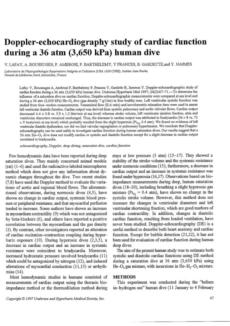
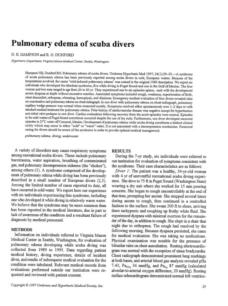

Authors: G. Racic, P.J. Denoble, N. Srem, L. Bojic and B.
Bota
This study aimed to evaluate the effectiveness of
hyperbaric oxygen (HBO2) versus prednisone in treating
79 Bell’s palsy, a condition that causes temporary facial
paralysis on one side of the face. The participants were
divided into two groups: 42 received HBO2, and 37 took
prednisone. The HBO2 group inhaled 100% oxygen at 2.8
atm abs for 60 minutes, twice daily, for up to 30 sessions
or until full recovery, and also took a placebo pill. The
prednisone group breathed 7% O2 at the same pressure
and schedule and received 450 mg of prednisone over
eight days. The findings indicate that HBO2 treatment is
more effective than prednisone for treating Bell’s palsy.
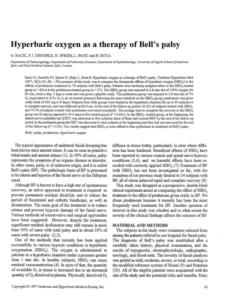

Authors: N.A.M. Schellart, M. Pollen, and A. Van Der Kley
The study investigated how different levels of oxygen and
pressure affect color vision and sensitivity to red and green
colors. The findings revealed that normal air pressure with
low oxygen enhances red sensitivity by 4%, while high
oxygen at the same pressure decreases it by 4%.
Hyperbaric oxygen showed a minor reduction in red-
green sensitivity, attributed to the counteracting effect of
increased carbon dioxide levels. No changes were
observed with normal air pressure and oxygen levels
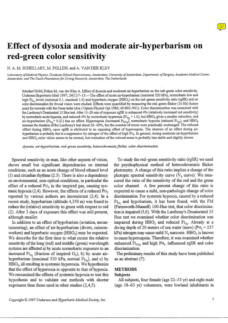

Authors: K.F. Koltyn and W.P. Morgan
The authors examined how wearing a wetsuit affects
divers' mental and physical responses. They found that
heart rate, air usage, and breathing effort increased in
both trials, but these increases were more significant
when divers wore wetsuits. Only in the wet suit trial did
the divers' core temperature rise significantly. Divers also
felt more anxious and aware of their bodies in the wet
suit. Interestingly, anxiety levels dropped significantly after
swimming without the wet suit. This suggests that
wearing a wet suit can make divers feel more anxious,
especially when it's warm, and the exercise is intense.
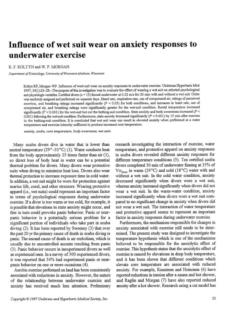

Authors: A. Nohara and T. Yusa
In this study, 90 rats were subjected to high-pressure
conditions and then rapidly decompressed to examine the
effects on their brain structures. Initially, there were
noticeable disruptions, but these issues were largely
resolved within 24 hours. However, the problems
reappeared about two to three days later. This suggests
that the initial recovery might be temporary, and longer-
term brain damage could occur due to the stress of
decompression.
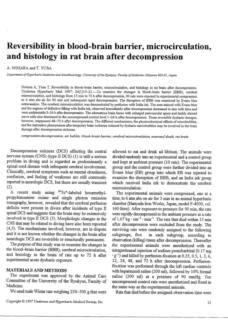

Authors: A. Boussuges, D. Carturcin, P. Ambrosi, G. Habib,
j. M. Sainty, R. Luccioni
This study aimed to determine how pulsed Doppler and
2D echocardiography can detect and measure blood
bubbles in divers after decompression.
The study concluded that pulsed Doppler was more
effective than 2D echocardiography in detecting and
measuring blood bubbles in divers after decompression.
However, further research is necessary to compare the
effectiveness of pulsed and continuous Doppler in
detecting these bubbles.
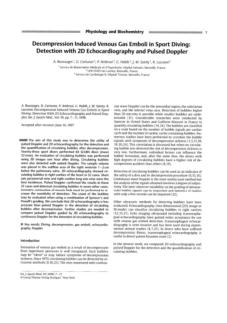

Authors: P. Gemonpre, P. Dendale, P. Unger, and C.
Balestra
This study was conducted on sports divers to investigate
whether a heart condition known as Patent Foramen
Ovale (PFO) could be the cause of unexplained
decompression sickness (DCS).
Based on the results, PFO is linked to unexplained DCS
related to the brain, but not to spinal DCS. The researchers
emphasized the need for standardized methods in future
studies that use this type of heart scan.
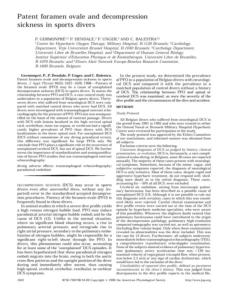

Authors: E.T. Flynn, E.C. Parker, R. Ball
From 1990 to 1994, Navy and Marine Corps divers
conducted 163,400 shallow no-decompression dives,
ranging from 21 to 55 feet deep, following U.S. Navy no-
decompression limits (USN57). During this period, 48
incidents were reported as possible decompression
sickness (DCS), with the majority identified as Type II DCS,
which contrasts with previous reports where Type I was
more prevalent. The study also examined the potential
impact of implementing more stringent no-decompression
limits (USN93), assuming diving patterns remained
unchanged..
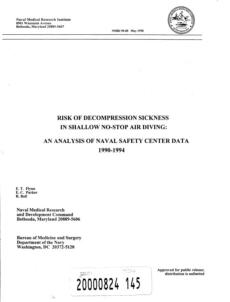

Authors: Erik C. Baker
The saying "an ounce of prevention is worth a pound of
cure" really applies when it comes to avoiding
decompression sickness. The best way to prevent it is by
following a proper decompression plan. Technical divers
have noticed that including "deep stops" in their diving
profiles helps prevent many problems. By understanding
how decompression works, we can adjust the model to
manage pressure differences better and calculate the
safest and deepest stops needed.
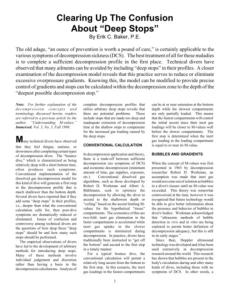

Authors:
B.D. Butler, R. Robinson, T. Little, J.E. Chelly, and M-F.
Doursout
The authors investigated the cardiovascular and
pulmonary responses of laboratory rats to moderate
decompression stress. Rats were compressed to 616 kPa
for 120 minutes and then decompressed at 38 kPa/min.
They concluded that moderate decompression profiles
cause detectable cardiovascular and pulmonary
responses in rats.
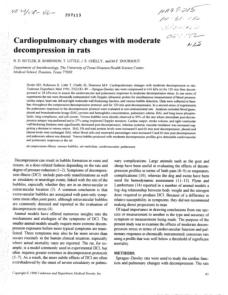

Authors:
Zexu Fang, James Sonner, Michael J. Laster, Pompi
Ionescu, Lori Kandel, Donald D. Koblin, Edmond I Eger
and Michael J. Halsey
The authors investigated the anaesthetic and convulsive
properties of 16 aromatic compounds (from benzene to
1,3,5-tris(trifluoromethyl)benzene) and four cycloalkanes
(from cyclopentane to cyclooctane). Some compounds,
such as benzene and cyclopentane, caused excitation,
while others, such as perfluorotoluene and cyclohexane,
caused convulsions. The results suggest that molecular
shape and size provide only limited insight into the
structure of the anaesthetic site of action.
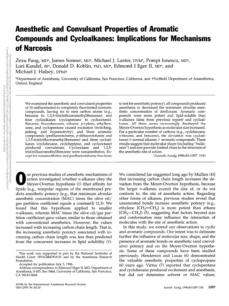

Authors: Joseph S. Beckman, & Willem H. Koppenol
Nitric oxide (NO) is unique among intercellular
messengers due to its rapid and isotropic diffusion
through tissues, although it cannot be transported
through the bloodstream because it is quickly destroyed
by oxyhemoglobin. While its direct toxicity is modest, it
becomes significantly more toxic when it reacts with
superoxide to form peroxynitrite, a selective oxidant that
modifies proteins by creating nitrotyrosines. This nitration
can disrupt protein assembly, leading to pathological
consequences.
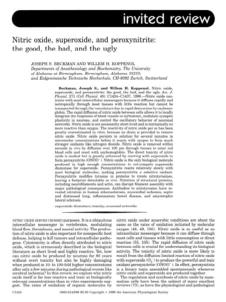

Authors: Val Vallyathan & Xianglin Shi
This paper explains the role of reactive oxygen species
(ROS) in causing lung injuries and diseases. The review
highlights both endogenous and exogenous sources of
ROS, focusing on occupational and environmental
exposures to various chemical substances. ROS can cause
cell injury and molecular alterations through various
mechanisms, including intracellular signaling and the
activation of proinflammatory cytokines. Understanding
these processes is crucial for preventing and mitigating
lung injuries from acute and chronic toxin exposure.

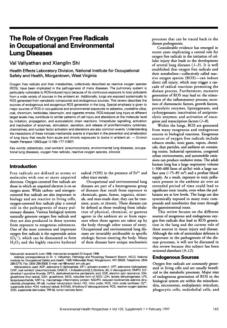

Authors: R. S. Lillo, E. C. Parker, and W. R. Porter
This study examined the differences in decompression risk
between helium (He) and hydrogen (H2) using 1,607
unanesthetized male albino rats. The rats, subjected to
dives with 2% oxygen balance at depths up to 50 ATA
and bottom times up to 60 minutes, were decompressed
to 10.8 ATA with varying profiles. Using maximum
likelihood analysis, the study estimated the relative
decompression risk ("potency") and the gas uptake and
elimination rate. The findings indicated that H2 has up to
35% greater potency for causing decompression sickness
compared to He.
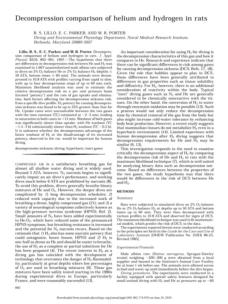

Author: Irwin Fridovich
The field of study concerning the biology of superoxide
anion radicals and related free radicals has matured
significantly. It is now known that superoxide and hydroxyl
radicals are produced in living systems, and there are
complex defense and repair systems in place to mitigate
their harmful effects. New defensive enzymes, such as
superoxide dismutase, catalase, and peroxidase, are
continually being discovered, along with new targets
affected by these radicals. The involvement of these
radicals in both physiological and pathological processes
is also being established.
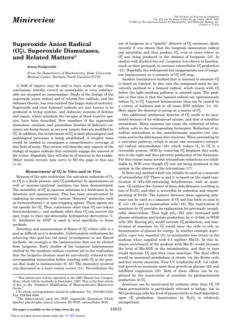

Authors:
Charles Y. Cheung, David J. Green, Gerald J. Litt, and
James A. Laugharn, Jr
This study demonstrated that high hydrostatic pressure
can disrupt immune complexes in two model systems:
prostate-specific antigen (PSA) with its antibody and
epiglycanin with its specific antibody.
The dissociated antibodies were able to rebind to their
antigens, indicating that the pressure-induced dissociation
was reversible. These findings suggest that high
hydrostatic pressure could enhance the sensitivity and
specificity of clinical assays.
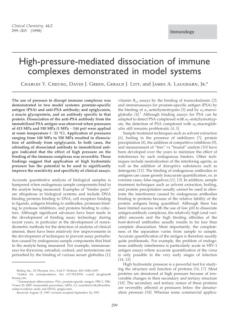

Authors: Catrine Ahlén, Ole Jan Iversen, Jan Risberg,
Gunnar Volden, Harald Aarset
This paper discusses clinical and epidemiological aspects
of a condition known as "diver's hand" based on studies
conducted in 1990, 1994, and 1995. It reveals that most
long-term saturation divers experience this condition at
some point in their careers. This condition can occur
without prior skin symptoms, and divers may experience
other skin issues during saturation periods. Diver's hand
appears to be specifically associated with saturation
diving.
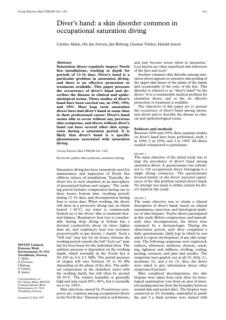

Authors: Athena Voultsios, David J. Kennaway, &
Drew Dawsont
This study aimed to develop and validate a salivary
melatonin radioimmunoassay to determine the phase
state of the biological clock, comparing it with traditional
plasma assays. The findings support the use of salivary
melatonin measurements for phase typing of the
melatonin rhythm in humans.
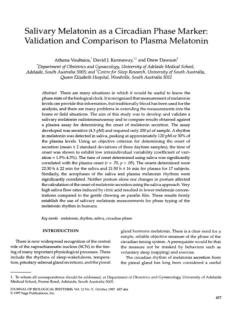

Authors: Leopold Schmetterer, Oliver Findl, Karin Strenn,
Ursula Graselli, Johannes Kastner, Hans-Georg
Eichler, and Michael Wolzt
The study examines the role of nitric oxide (NO) in
regulating cerebral and ocular blood flow in response to
CO2 and O2 levels. Using L-NMMA in young subjects,
researchers measured blood flow velocities and ocular
fundus pulsation. L-NMMA reduced pulsations and slightly
decreased flow velocities. Hypercapnia increases flow
velocities in the middle cerebral artery and fundus
pulsation amplitude. The responses were blunted by L-
NMMA, indicating NO's role in hypercapnia-induced
vasodilation. L-NMMA did not affect hyperoxia-induced
changes.


Authors:
Juan J. Poderoso, Jorge G. Peralta, Constanza L. Lisdero,
María Cecilia Carreras, Marcelo Radisic, Francisco Schopfer,
Enrique Cadenas, and Alberto Boveris
The study examined how nitric oxide (NO) and bradykinin
impact myocardial oxygen (O2) uptake in isolated rat
hearts. It showed a reduction in O2 uptake with increased
NO concentrations, and higher levels of NO led to
elevated hydrogen peroxide (H2O2) release and inhibited
O2 uptake in isolated rat heart mitochondria. NO was
found to hinder electron transfer at cytochrome oxidase
and between cytochrome b and cytochrome c, mainly
binding to myoglobin and affecting mitochondria.
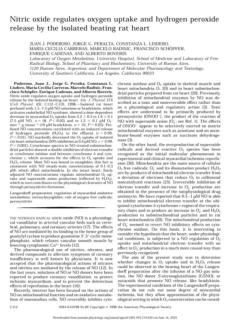

Authors:
Catrine Ahlén, Lise Helen Mandal, Ole Jan Iversen
This study focuses on skin infections among occupational
saturation divers, particularly those caused by
Pseudomonas aeruginosa, from 1987 to 1995 in the
North Sea. It aims to document the occurrence of P.
aeruginosa in these infections, its presence in diving
environments, and the relationship between infection
strains and environmental isolates.
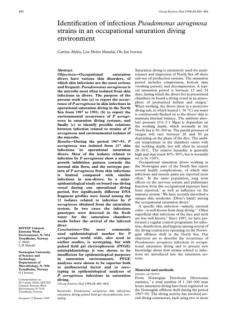

Authors:
Muhammad M. Hammani, Abderrezak Bouchama, Essam
Shail, Hassan Y. Aboul-Enein, Sultan Al-Sedaury
This study analyzed circulating lymphocyte changes in
heatstroke patients before and after cooling, compared to
heat-stressed controls. Findings suggest heatstroke causes
significant alterations in lymphocyte subsets, which are
not entirely normalized by cooling and are unrelated to
catecholamine levels. Heat stress results in similar but
milder changes, indicating a continuum between
heatstroke and heat stress.
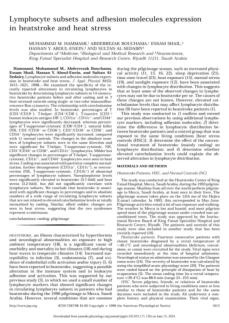

Authors: Fumio Yamazaki, Keizo Shiraki, Sueko Sagawa,
Yutaka Endo, Riko Torii, Hitoshi Yamaguchi,
Motohiko Mohri, and Yu-chong Lin
This experiment studied the autonomic nervous system in
hyperbaric bradycardia. Four male divers were in a heliox
environment at 24 atm abs for seven days. Heart and
respiratory rates were measured during different phases.
Results showed a stable morning heart rate but a
decreased nighttime heart rate initially. Parasympathetic
activity increased on the first night, but sympathetic activity
did not change. Increased parasympathetic activity causes
bradycardia during heliox dives. The gradual
disappearance of bradycardia may be due to
cardiovascular deconditioning.
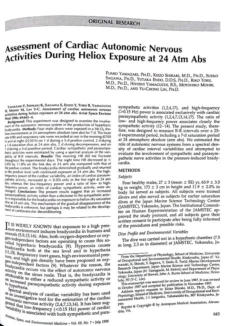

Authors: A. Boussuges, P. Blanc, F. Molenat, E.
Bergmann, J.M. Sainty
This study discusses the relationship between
haematocrit levels and neurological decompression
illness (DCI) in sports divers. It determines if there is a
correlation between haematocrit levels and the
prognosis of neurological sequelae in divers affected
by DCI. It also provides statistical analysis highlighting
that a higher haematocrit level is associated with
persistent neurological sequelae.
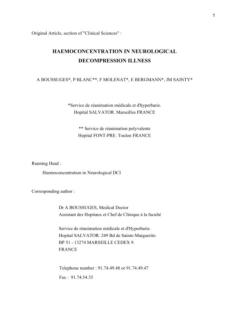

Author: G. Jacobsen, J. E. Jacobsen, R. E. Peterson, J. H.
McLellan, S. T. Brooke, T. Nome, A. O. Brubakk
This document presents and analyzes data from a
comprehensive database of diving activities conducted by
a Norwegian offshore diving contractor, focusing on the
incidence of decompression sickness (DCS) among divers.
It discusses the development of a theory that aims to
predict DCS based on exposure factors and describes a
study using a case-control design to identify characteristics
of dives that resulted in DCS. It also highlights the
relationship between pressure changes during dives and
the likelihood of DCS, suggesting that some dive
characteristics, such as multiple storage depths and
significant pressure changes, increase the risk of DCS.
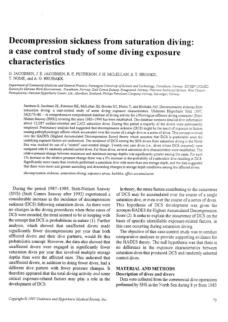

Authors: A.A. Bove
This study investigates the relationship between the
presence of a patent foramen ovale (PFO) and the risk of
developing decompression sickness (DCS) in divers. It uses
statistical methods, such as Logistic Regression and Bayes'
theorem, to analyze data from multiple studies. The
findings suggest that while having a PFO increases the
odds of developing serious DCS, the overall risk remains
small and does not justify routine echocardiographic
screening for divers.

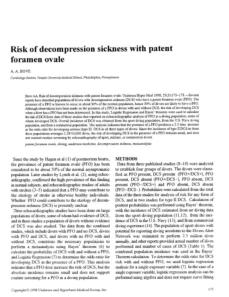

Authos: C. Balestra, P. Germonpre, and A. Marroni
This paper presents research findings on the risks
associated with some physical maneuvers for scuba divers
with a patent foramen ovale (PFO). It informs and advises
divers, particularly those with PFO, about the potential
dangers of performing specific exercises that can lead to
paradoxical nitrogen gas emboli due to changes in
intrathoracic pressure. It concludes with a
recommendation for divers to avoid strenuous exercises
after decompression dives to mitigate these risks
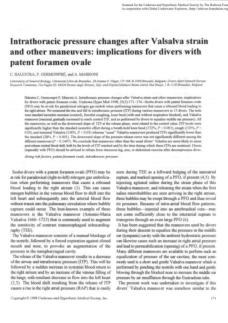



03 - Evolution and offshore performances of the Comex Treatment
Tables.
- Published by the Undersea & Hyperbaric Medical Society

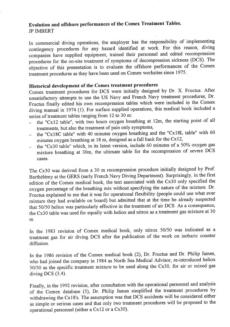
Author: Jean Pierre Imbert
This document was published during the Workshop on
Decompression Illness Treatment. Undersea Biomedical
Hyperbaric Society, Palm Beach, Florida - June 1996
Employers must set up contingency plans for any work
hazards in commercial diving. Diving companies provide
equipment, train staff, and revise recompression
procedures for treating decompression sickness (DCS).
This presentation assesses the offshore effectiveness of
Comex treatment procedures used since 1975.

Author: D. J. Valaik, E. C. Parker, S. S. Survanshi
This document is a presentation of the “Real Time Dive
Planner, a flexible method of calculation that was
approved for use in support of Naval Special Warfare
(NSW) diving operations in May 1994


10 - Calculating Decompression in Naval Special Warfare SEAL
Delivery Vehicle Diving Operations Utilizing the Real Time Dive
Planner
- Published by the Naval medical research institute
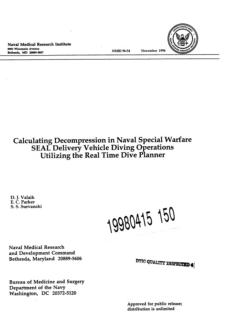
Authors: Michael Knauth, Stefan Ries, Stefan Pohimann,
Tina Kerby, Michael Forsting, Michael
Daffertshofer, Michael Hennerici, Klaus Sartor
This study investigates how a patent foramen ovale may
contribute to multiple brain lesions in sport divers who
did not report decompression symptoms. It is a
prospective double-blind cohort study involving 87 divers
with at least 160 scuba dives. The main outcomes
measured were brain lesions seen in MRI and the
presence and size of patent foramen ovale using
echocontrast transcranial Doppler ultrasonography.
Findings showed that 25 divers had a right-to-left shunt,
with multiple brain lesions found mainly in those with a
large patent foramen ovale, suggesting a link to gas
embolism.


20 - Cohort study of multiple brain lesions in sport divers: Role of a
patent foramen ovale.
- Published by the BMJ

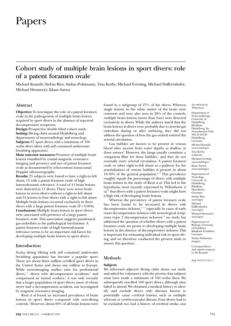



29 - Concervative management of gastric rupture following scuba
diving
- Published by the BMJ Journals (Author-released)
Author: J D Hunter, C A Roobottom, Ph Bryson, C Brown
Gastric rupture is an uncommon surgical problem which
normally presents with an acute abdomen and
peritonism. Aan nusual case following underwater ascent
and its conservative management is presented.
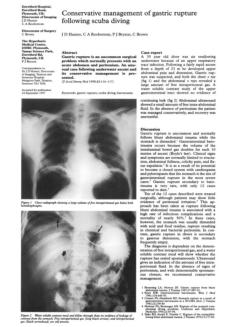


36 - The Importance of Deep Safety Stops: Rethinking Ascent
Patterns From Decompression Dives
- Published by the State of Hawaii Museum of Natural and Cultural History
Author: Richard L. Pyle
The author of this article believes that deep stops help
avoid decompression sickness by controlling bubble size
and, therefore, improving safety. He concludes by
suggesting divers explore this practice but reminds them
to prioritize their own safety.
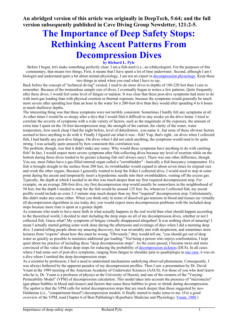



Authors: W. Sterkl, N. vinré, and R. Takashima
The Netherlands Diving Centre (NDC) created
decompression tables, known as DADCODAT (DCD)
tables, in 1988 using a specific computational model.
These tables aimed for a decompression illness (DCI) rate
of no more than 0. 5%. Users were required to report dive
data to NDC until 1994, when data collection stopped
due to perceived sufficiency. Recently, concerns arose that
DCI rates might exceed the acceptable limit after air diving
at depths between 45 and 50 msw, especially during
NDC courses, prompting further investigation.
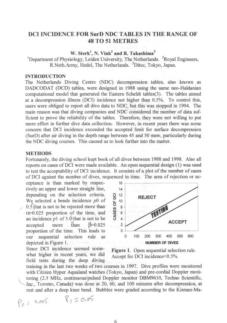

Author: Erich W Russi
Pulmonary barotrauma (PBT) of ascent is a feared
complication in compressed air diving. Although certain
respiratory conditions are thought to increase the risk of
suffering PBT and thus should preclude diving, in most
cases of PBT, risk factors are described as not being
present. The purpose of the study was to evaluate factors
that possibly cause PBT. Design. The authors analyzed 15
consecutive cases of PBT with respect to dive factors,
clinical and radiologic features, and lung function. They
were compared with 15 cases of decompression sickness
without PBT, which appeared in the same period.


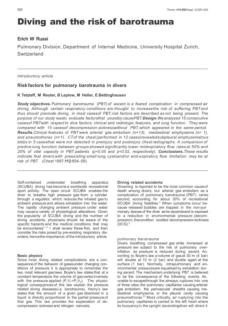



09 - Effects of N2O narcosis on breathing and effort sensations
during exercise and inspiratory resistive loading.
- Publised by the Journal of Applied Physiology

Author: D.M. Fothergill, & A. Carlson
This study on thirteen male US Navy divers revealed that
breathing 23% nitrous oxide moderately affected
respiratory effort, but did not impair exercise tolerance or
depress ventilatory reflexes during resistive breathing
exercises.
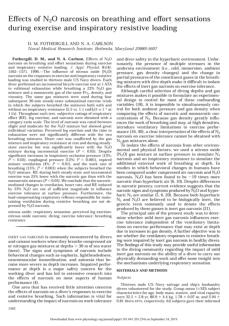

The Convention for the Protection of Human Rights and
Dignity of the Human Being with regard to the
Application of Biology and Medicine, commonly known
as the Oviedo Convention, is an international treaty
aimed at protecting human rights and dignity in the
biomedical field. It was opened for signature in Oviedo,
Spain, on April 4, 1997.


21 - Convention for the Protection of Human Rights and Dignity of
the Human Being with regard to the Application of Biology and
Medicine: Convention on Human Rights and Biomedicine
(Convention of Oviedo)
- Published by the Council of Europe
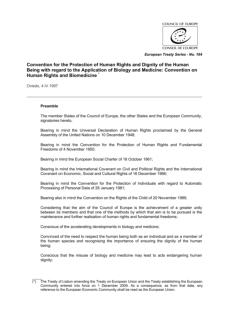

Author: Shi Zhnog-yuan
This study investigated the safety and performance of
helium-nitrogen-oxygen excursions from nitrox saturation
at significant depths. Four divers were saturated in
nitrogen-oxygen conditions and completed excursions to
60 and 80 msw using a specific trimix gas.
Decompression procedures based on Hamilton's
methods were followed, yielding effective results. While
some bubble grades persisted post-dive, no major
symptoms were reported, suggesting that deep diving
with helium-rich mixtures is feasible and safe with proper
protocols.


51 - Experiment of nitrox saturation diving with trimix excursion
- Published by the Journal of physiological anthropology

